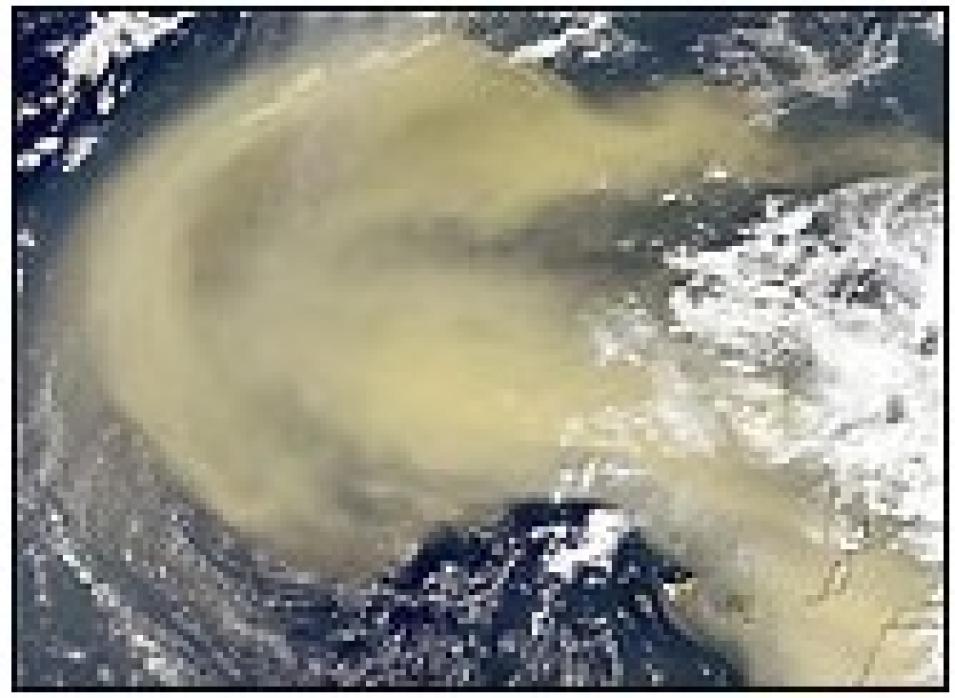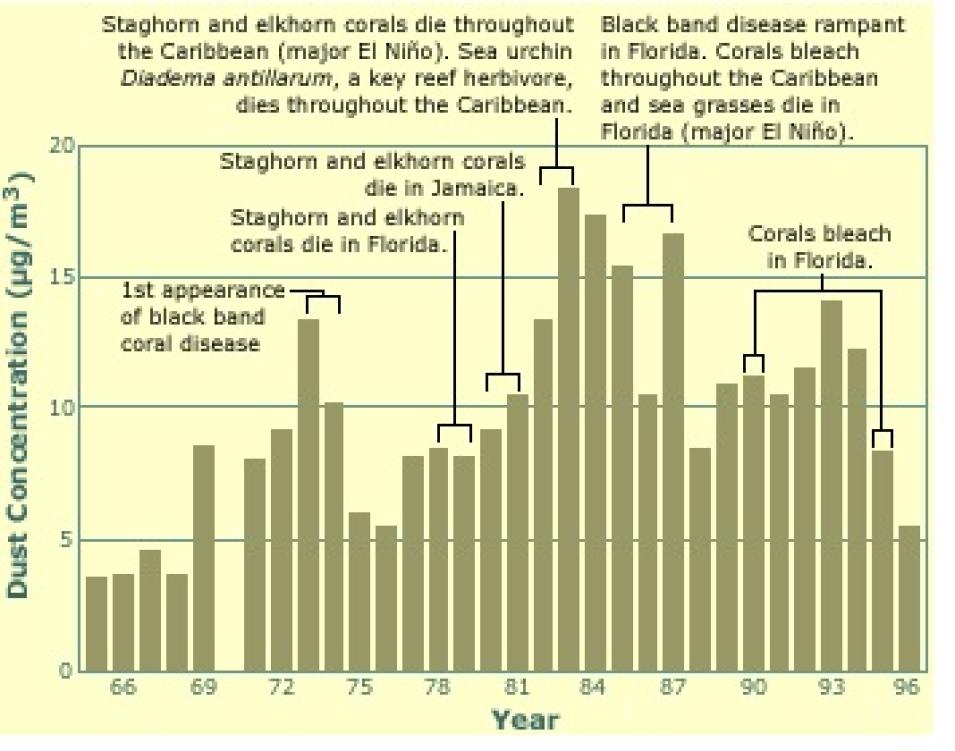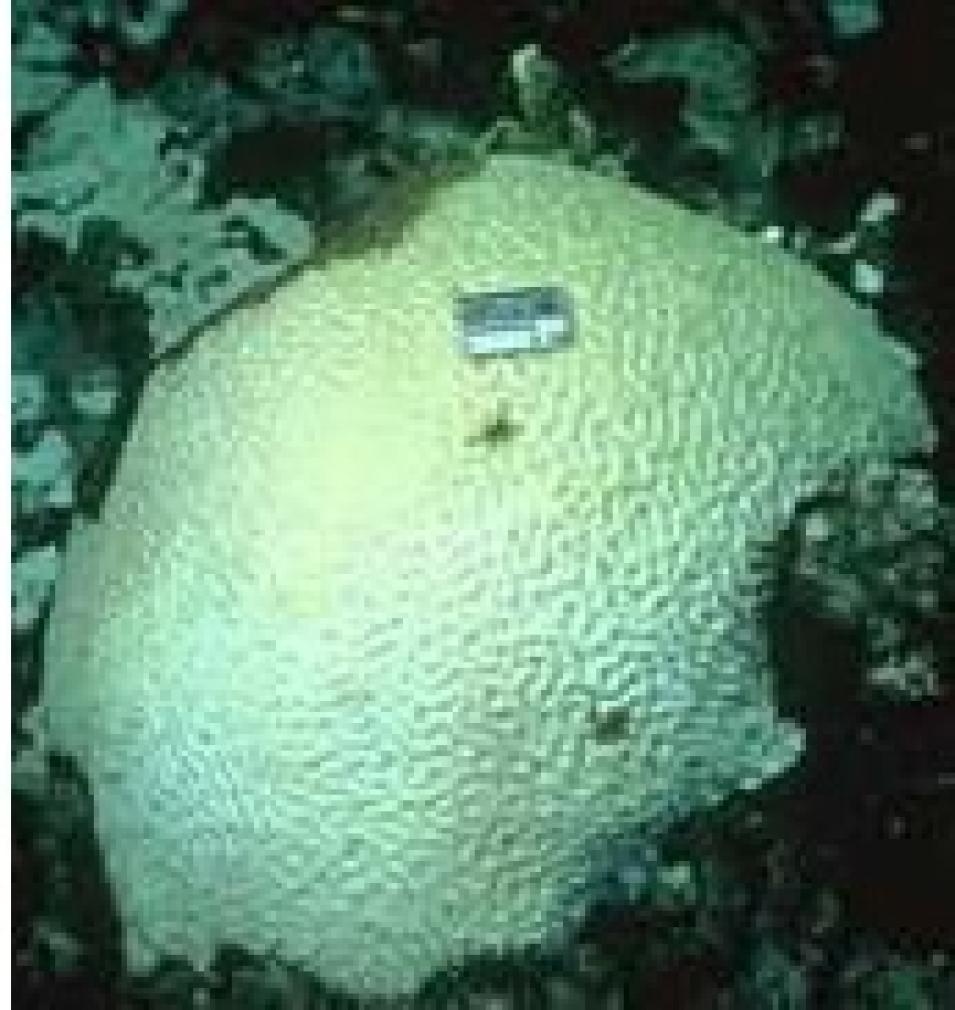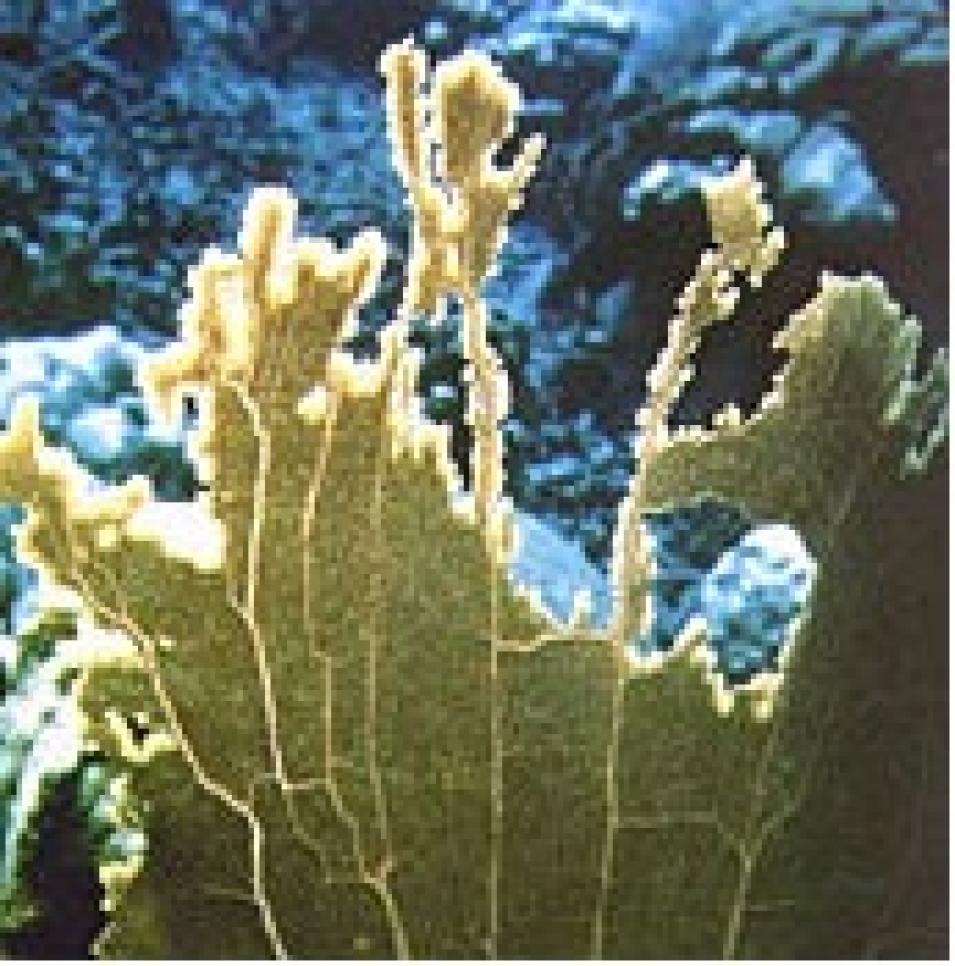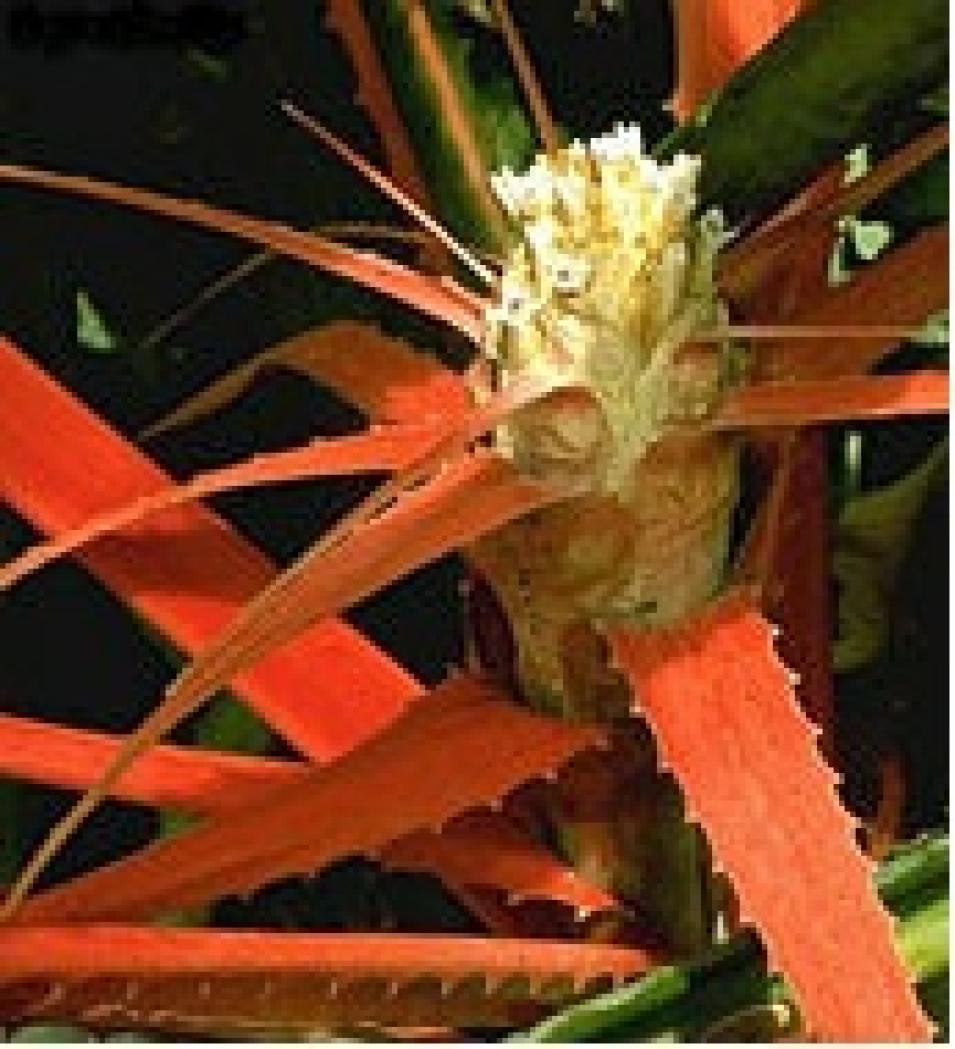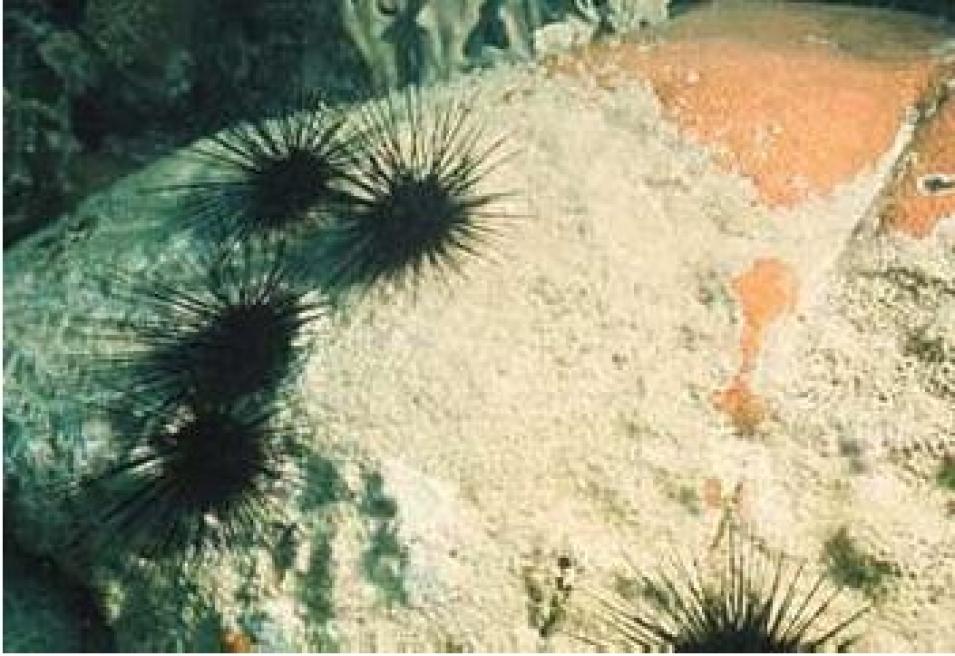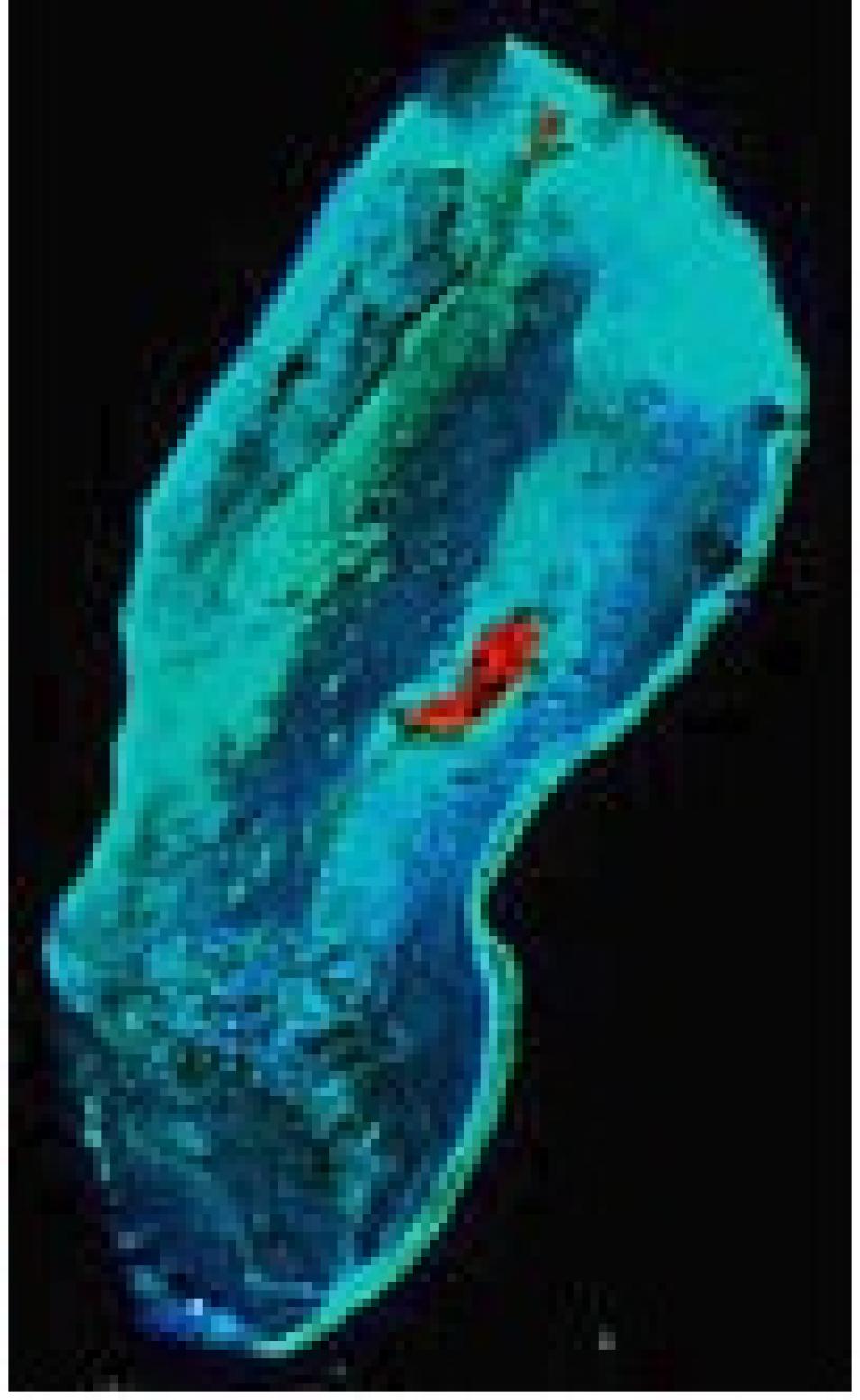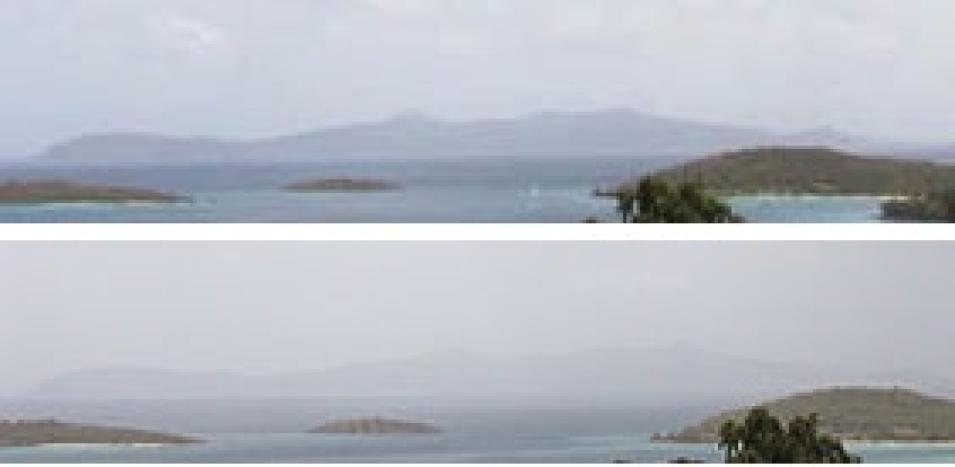Each year, several hundred million tons of African dust are transported westward over the Atlantic to the Caribbean, Central America, and South America. Summer storms and accompanying warm air can lift dust as high as 15,000 feet above the African deserts, and then out across the Atlantic.
When the Dust Settles
Now, thanks to satellite imagery, scientists can observe the path of transport. The ability to see dust storms from space, coupled with soil analyses, are leading some researchers to theorize a relationship between degradation of Caribbean marine species and airborne pathogens. The researchers also believe the dust may be contributing to human health problems.
Reef inhabitants produce a profusion of color in the Caribbean. (Image courtesy of Sustainable Seas Expeditions).
Since the 1970s, coral reefs in the Caribbean have been in a state of continual decline, and several other marine species suffered mass mortalities in 1983. Coincidentally (from 1970 to the present), transatlantic dust transport from North Africa increased dramatically, with peak dust years occurring in 1973, 1983, and 1987, according to a group of scientists.
"Our hypothesis is that much of the coral reef decline in the Caribbean is a result of pathogens transported in dust from North Africa," said Gene Shinn, senior geologist at the U.S. Geological Survey (USGS) Center for Coastal Geology in St. Petersburg, Florida. Shinn, who has spent most of his career studying marine sediments and ground water movement, has witnessed dramatic changes in coral reefs during the last four decades. "I started taking pictures of individual reef areas back in 1959, and the photo record shows that the reefs have been steadily declining," he said.
Then Shinn came across a graph of African dust flux developed by Joe Prospero, an atmospheric chemist at the University of Miami, who had been measuring dust on the island of Barbados since 1965. The graph showed dramatic increases in dust flux beginning with the onset of the drought in North Africa that started around 1970, with peak years occurring in 1973, 1983, and 1987. "I knew these were significant years, especially 1983 and 1987, for certain species mortalities that occurred in the Caribbean," said Shinn.
Barbados Mineral Dust Annual Average and Benchmark Caribbean Events
Dust deposition peaked in 1983 and 1987, years when extensive environmental change was evident in Caribbean coral reefs. (Image adapted from the USGS Center for Coastal Geology: Coral Mortality and African Dust, courtesy of Dr. Joe Prospero, University of Miami).
Extending throughout coastal zones of warm tropical and subtropical waters, coral reefs are among the world's most diverse and productive ecosystems. The large, wave-resistant structures are formed by colonies of billions of tiny coral animals, called polyps, which secrete hard calcium carbonate skeletons for protection. Accumulations of these hard skeletal structures build up coral reefs over time. Coral reef growth rates vary, depending on the species of coral and environmental conditions, ranging from 0.3 to 10 centimeters per year.
Reef-dwelling corals have a mutually beneficial, or symbiotic, relationship with plant-like algae called zooxanthellae. These algae produce food, via photosynthesis, and also provide the coral polyps with their brilliant color. In a process known as "coral bleaching," corals under environmental stress expel these algae from their tissue, exposing the colony's white calcium carbonate skeleton. Episodes of coral bleaching proliferated in Florida and the Caribbean in the late 1980s and 1990s, with a major event occurring in the summer of 1987, Shinn's team reported in the October 1, 2000 issue of Geophysical Research Letters.
A species of soft coral, called sea fans, suffered a widespread die-off in 1983, and again in the mid-1990s. Environmental scientists have long suspected that a pathogen was released into the environment and spread to the Caribbean region. But the pathogen was never identified.
When a brain coral expels the symbiotic algal cells that give it color, it is bleached like this coral. Coral bleaching is associated with warm water conditions, especially during the years of maximum dust transport. However, dust alone has not been proven to cause coral bleaching. (Image courtesy of the USGS Center for Coastal Geology: Coral Mortality and African Dust).
In 1983, a species of long-spined sea urchin, called Diadema antillarum, experienced severe mortality that decimated the entire population within one year. Diadema are herbivores that crawl on reefs eating the algae, a process which keeps the reef clean. "When a new coral larva lands on a clean rock surface it has a good chance of propagating, but if the rock surface is covered with algae, it's very difficult for new coral growth to begin," Shinn said.
The unknown pathogen first struck Diadema populations in Panama in mid-January, 1983, the team reported, and by the following July had spread to reefs in Belize, Mexico, and the Florida Keys. This path suggested rapid movement of the suspect pathogen in the main Caribbean current, a deduction that supports the team's dust transport hypothesis.
Scientists have long known that dust clouds travel long distances. Iron- and clay-rich soils found on many Caribbean islands originated as dust from Africa, and studies show that essential nutrients in Hawaiian rainforests are transported via dust from Asia. African dust also supports a robust bromeliad-based ecosystem high in the tree canopy of the Amazon rainforest, according to Shinn. "The ecosystem in the tree canopy is based on red soil and includes various bugs and worms," he said.
A long-term drought in the Sahel region of North Africa that began in the early 1970s, along with overgrazing and the drying of Lake Chad, are believed to contribute to the increase in dust that is carried across the Atlantic Ocean (see From the Dust Bowl to the Sahel). "We know that the variations in dust concentration measured in the Caribbean and Western Atlantic correlate with rainfall deficits in North Africa, especially in the Sahel region," said Prospero. "If the dust is altering the health of ecosystems, then this could be a significant climate-related effect."
On February 26, 2000, NASA's Sea-viewing Wide Field-of-view Sensor (SeaWiFS) captured a massive dust storm as it blew off the coast of North Africa and reached 1,000 miles into the Atlantic. The SeaWiFS instrument, part of NASA's Earth Science Enterprise (ESE) project, collects global data on earth's oceans and land every two days and is the first mission capable of monitoring the global biosphere. Since the orbiting sensor can view all cloud-free ocean regions every 48 hours, SeaWiFS data have proven useful in atmospheric science research.
African dust contains spores of a fungus that can be destructive to sea fans. This sea fan has suffered damage from a fungal infection. (Image courtesy of the USGS South Florida Restoration Science Forum).
Data from the Total Ozone Mapping Spectrometer (TOMS), available from NASA's Goddard Space Flight Center, provides the scientists with "real-time" images of dust storms. The TOMS is the first instrument to allow observation of aerosols as the particles cross the land/sea boundary. "I can look at TOMS data on NASA's Web site and see a dust storm coming; then my colleague in the Virgin Islands confirms that visibility is only about two miles that day," said Shinn.
In addition, remote sensing data from NASA's Landsat 7 satellite enable coral researchers to map and monitor the health of coral reefs around the world (see Mapping the Decline of Coral Reefs). By looking at the variability of the pixels' brightness on a set of Landsat images, scientists can map the extent of change a reef has undergone and, by observing color fluctuations, can even identify when a reef changes from living (polyp-covered) to non-living (algae-covered).
"Some early studies surmised the transport flow, but the advent of remote sensing is what really made it possible to see the dust's precise course," said Shinn. Satellite imagery shows that African dust is transported mainly toward the Caribbean and equatorial regions of South America during North American winters, and then shifts north towards Florida and the Southeast United States during summers, the team reported in their paper.
"You have to live in the Virgin Islands to fully comprehend the amount of red dust people clean from boat sails, decks, and window screens there," said Shinn.
Ginger Garrison, a USGS marine ecologist who lives on a boat in the U.S. Virgin Islands, understands the situation better than most. "During an African dust event, our normally clear blue skies turn a hazy gray, and visibility degrades from unlimited to only a few kilometers," she said.
Using a vacuum pump, Garrison set up a filtering device that captures dust samples, which she then places in sterile containers and sends to microbiologists working with the team. Dale Griffin, a post-doctoral microbiologist hired with funding from NASA, cultures and identifies microbes in the dust samples. So far, Griffin and team member Christina Kellogg have cultivated over 130 bacteria and fungi isolates, most of which came from samples collected during Caribbean dust events that occurred in 2000.
"We typically isolate about two colonies of fungi from clear air samples, whereas we might recover 20 to 40 isolates of fungi and bacteria from samples taken during dust events," said Griffin. Griffin's studies also show the presence of viruses in the dust, although further species identification needs to be done.
According to Shinn, the team's finding that viable microorganisms are making the journey in the dust was surprising. "Most microbiologists will tell you that ultraviolet light kills bacteria during an exposure time of five to six days," said Shinn.
But Griffin said that overlying dust clouds, as well as smoke from slash-and-burn agriculture, might act as a filter, depleting ultraviolet (UV) sunlight. "Microbes at lower altitudes in the dust clouds receive lower doses of UV, which could enable them to survive," he said. Another possibility, according to Griffin, is that the microbes may adhere to cracks or crevasses on dust particles, which could protect them via shading.
A correlation between increased dust and outbreaks of the disease that struck the Caribbean sea fans also appears to exist. Garriet Smith, a researcher at the University of South Carolina, identified Aspergillus, a soil fungus, as the cause of sea fan disease. But since Aspergillus does not reproduce in seawater, a constant supply of spores was needed to explain the ongoing nature of the disease. Later, Smith and colleagues isolated Aspergillus sydowii from the dust samples and inoculated healthy sea fans with the culture, achieving a 50 percent positive reaction. "So far, that is the best smoking gun we have for proof that microbes transported in the dust are having a detrimental ecological effect," said Shinn.
Photographed before 1983, Diadema sea urchins keep a dead coral surface free of algae. In the summer of 1983, most Diadema urchins died, leaving the coral covered with algal mats that impeded establishment of coral larvae. (Image courtesy of the USGS Center for Coastal Geology: Coral Mortality and African Dust).
"Occasionally, swarms of large grasshoppers get caught up in the dust and make it all the way from Africa to the Caribbean — alive," said Shinn. Pesticides, many of which have been banned in the U.S., have also been detected in African dust that accumulates in drinking water cisterns in the Caribbean, according to Shinn.
Heavy metals, including mercury and arsenic, and elevated levels of lead-210 and a naturally-occurring radioactive isotope known as beryllium-7, have also been detected, Shinn said. But according to USGS geologist Chuck Holmes, these levels can't be characterized as dangerous until further studies are done.
In addition to affecting marine ecosystem health, the researchers suspect that the dust may trigger respiratory health problems in humans. According to Shinn, levels of asthma on the islands of Barbados and Trinidad are among the highest in the world. "The incidence of asthma on Barbados and nearby Trinidad, as documented by the Caribbean Allergy and Respiratory Association (CARA), has increased 17-fold since 1973," he said. "And that was the first year that Prospero's graph showed a big spike in the dust record there."
The St. Petersburg Times reported that the number of Americans with asthma has increased 154 percent since 1980. Hillsborough County, Florida, which includes the Tampa Bay region, has one of the state's highest asthma rates, with 7.1 percent of students now reporting asthma symptoms, compared to 2.7 percent just four years ago.
In this Landsat image, red indicates vegetation growing on a small island off the coast of Mexico (known as Chincorro Bank). The blue-green regions around the island represent shallow coral reef areas. (Image courtesy Serge Andrefouet, University of South Florida, and the Landsat 7 Team).
"According to Prospero's work, about half the particles breathed in South Florida during summer months originate in Africa," said Shinn. "The asthma epidemic in areas that are relatively free of industry correlates with the increased flux of African dust that has been continuously monitored in Barbados since 1965."
Prospero is proposing a study to examine increased outbreaks of asthma in the Caribbean. "We will use remote sensing to look at the relationship between the number of people presenting asthma symptoms at hospital emergency rooms and the occurrence of African dust," he said. If approved, Prospero's study will include culturing dust samples for the presence of fungi, pollen, and other microorganisms.
But researchers need to exercise caution in interpreting results, according to Prospero. "Not a lot is known about wind-transported disease," he said. "At this point, it's a hypothesis that has some supporting evidence. But it's a complicated subject."
Shinn said his immediate goal is to continue identifying microbes in the dust. "Proving or disproving a causal relationship between African dust and coral reef demise has the potential to redirect research efforts more wisely," he said.
The decline of coral reef health is generally attributed to pollution, sedimentation, or warm water associated with the North Atlantic and El Niño Southern Oscillations. In a 1999 article published in Science, Harvell and colleagues reported that a dramatic global increase in the severity of coral bleaching in 1997-98 was coincident with high El Niño temperatures.
While Shinn acknowledges that changes in water temperatures have contributed to or caused coral bleaching, he claims that some damaged coral reefs are located in isolated areas where pollution or runoff do not occur. "Elevated water temperatures from El Niño caused widespread coral bleaching, but pollution and sedimentation do not explain why coral reef disease occurs in regions that are remote and unpopulated," he said.
In addition to analyzing microbes in the dust, Shinn plans to collect 20-foot sediment cores from an offshore sink hole near Belize — samples that he hopes will provide several thousand years of dust transport history.
"Our findings so far demonstrate the need for further studies," said Shinn. "If soil dusts serve as carriers for microbes, pesticides, heavy metals, and insects, then monitoring and prediction of these transatlantic dust events is warranted."
References
Allison, W., 2000. Breathing Lessons: Learning to Live with Asthma. St. Petersburg Times. February 11, 2000.
Harvell, C.D., K. Kim, J.M. Burkholder, R.R. Colwell, P.R. Epstein, D.J. Grimes, E.E. Hofman, E.K. Lipp, A.D.M.E. Osterhaus, R.M. Overstreet, J.W. Porter, G.W. Smith, and G.R. Vasta. 1999. Emerging Marine Diseases — Climate Links and Anthropogenic Factors. Science.285(5433), pp. 1505-1510.
Shinn, E.A., G.W. Smith, J.M. Prospero, P. Betzer, M.L. Hayes, V. Garrison, and R.T. Barber. 2000. African Dust and the Demise of Caribbean Coral Reefs. Geophysical Research Letters. 27(19), pp. 3029-3032.
African Dust Causes Widespread Environmental Distress. USGS Information Sheet. April 2000. http://coastal.er.usgs.gov/african_dust/. Accessed April 19, 2001.
For more information
NASA Goddard Earth Sciences Data and Information Services Center (GES DISC)
NASA Land Processes Distributed Active Archive Center (LP DAAC)
| About the remote sensing data used | ||
|---|---|---|
| Satellite | Landsat 7 | |
| Sensor | Sea-viewing Wide Field-of-view Sensor (SeaWiFS) Total Ozone Mapping Spectrometer (TOMS) | |
| Parameter | African dust transport and marine species declines | African dust transport and marine species declines |
| DAAC | NASA Goddard Earth Sciences Data and Information Services Center (GES DISC) | NASA Land Processes Distributed Active Archive Center (LP DAAC) |
SeaWiFS and TOMS data products are distributed through GES DISC. Landsat data products are available through LP DAAC.
